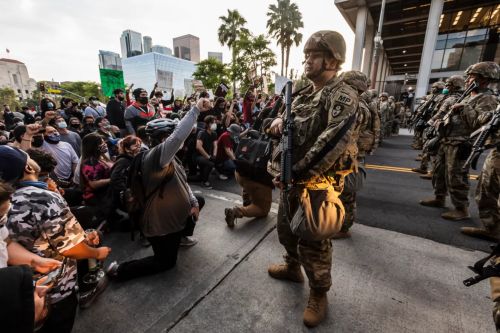

By protecting one form of extremism while exploiting another, Trump has blurred the line between the governed and the governing, between the state’s authority and his own ambition.

By Matthew A. McIntosh
Public Historian
Brewminate
Introduction
As President Donald Trump nears the final stretch of the first year of his second term, his public rhetoric and executive posture reveal a troubling duality: excusing violence from his supporters while stoking and exploiting unrest among his critics. The pattern is deliberate and strategic, a choreography of outrage designed to tighten his control over the instruments of state power.
In recent months, Trump has minimized acts of right-wing aggression, from militia threats to intimidation campaigns, while amplifying isolated instances of left-wing protest into national crises. He has repeatedly targeted individuals and groups with threats or rhetorical violence, portraying political opponents as internal enemies. Meanwhile, when far-right actors engage in intimidation or outright assault, he frames them as patriots defending “law and order.”
This asymmetry has become central to his governance. Trump’s reaction to violence is less about principle than about allegiance: unrest from the left invites repression; aggression from the right earns indulgence. His use of the presidency to polarize state response mirrors earlier authoritarian strategies, cultivating disorder as both political theater and rationale for control.
The effect is corrosive. By normalizing one form of violence and weaponizing another, Trump has transformed the language of security into a tool of dominance. Each provocation, each selective condemnation, tightens the feedback loop between fear and authority. The result is a nation where violence is not only tolerated, but managed, a political resource rather than a social failure.
Normalizing Right-Wing Violence
From his earliest rallies to the present day, Trump has treated right-wing violence less as a threat to public order than as an expression of patriotic zeal. His refusal to condemn acts of aggression by supporters (whether armed protesters, extremist militias, or self-styled “defenders of freedom”) has given violent rhetoric a legitimacy unseen in American politics for generations.
In the past year, Trump has repeatedly praised or excused the actions of his most militant followers. Following the demonstrations in Los Angeles, he avoided directly condemning those who attacked counter-protesters, instead insisting that people are just defending their country. When pressed by reporters, his aides framed the incidents as “isolated acts” provoked by “radical left agitators.” This framing is not new; it echoes his earlier responses to far-right violence during his first term, when he infamously described white nationalists in Charlottesville as including “very fine people.”
Such rhetoric serves a political purpose. By downplaying the threat posed by right-wing extremists, Trump signals that violence in defense of his cause will be tolerated, even valorized. His administration has shown little interest in addressing far-right extremism despite repeated warnings from national security agencies. In statements and social media posts, Trump has instead redirected blame toward “antifa,” “Marxists,” and “traitorous” Democrats, portraying his opponents as enemies of the state while ignoring the growing body of evidence linking right-wing movements to domestic terrorism.
The normalization of violence extends beyond rhetoric. During his rallies and public appearances, Trump has praised individuals convicted of violent acts, from January 6 rioters (all of whom he pardoned) to militia members involved in plots against officials. He refers to them as “political prisoners,” framing their prosecutions as persecution by a corrupt government. This narrative not only reinforces loyalty but blurs the boundary between political support and criminal action. It tells followers that violence committed in his name is not merely excusable; it is righteous.
In effect, Trump’s indulgence of right-wing aggression redefines citizenship around allegiance to him personally rather than adherence to the law. Violence becomes a credential of authenticity, proof of belonging to a persecuted but “real” America. By celebrating the perpetrators and delegitimizing their critics, Trump has turned vigilantism into virtue, leaving the institutions of justice struggling to hold moral ground.
Spotlighting Left-Wing Violence and Mobilizing State Power
While Trump routinely minimizes or excuses violence committed by right-wing groups, he exhibits the opposite reflex toward the political left, magnifying isolated incidents into existential threats and using them to justify sweeping expansions of state power. The same unrest that he tolerates or rationalizes among his supporters becomes, in his opponents, proof of sedition.
This strategy surfaced again when Trump recently invoked the possibility of deploying the Insurrection Act in Chicago. He claimed the move was necessary to “restore order” after clashes between anti-Trump demonstrators and police, though Illinois Governor J.B. Pritzker publicly dismissed the claim as “political theater.” The threat was characteristic of Trump’s approach: escalate the rhetoric, portray dissent as danger, and present federal intervention as the only remedy.
His administration’s communications have followed the same pattern. When protests erupted in major cities this summer, Trump described them as “Marxist riots” and “terrorist attacks,” a framing repeated across state-friendly media. He called for the Justice Department to “crack down on leftist extremism,” proposing new domestic terrorism designations that not only doesn’t have the lawful authority to do but also risk criminalizing legitimate protest. These announcements coincided with aggressive federal surveillance measures targeting activist networks, a reminder that his political messaging often precedes administrative action.
By recasting social protest as insurrection, Trump not only mobilizes the machinery of enforcement but also conditions the public to accept its expanded use. His “law and order” narrative turns civic unrest into justification for militarized policing and discretionary executive authority. The result is an uneven deployment of state power: leniency for loyalists, force for dissenters.
This asymmetry transforms law into spectacle. Each televised crackdown reinforces the illusion of chaos, fueling support for the very powers Trump seeks to consolidate. As protests spread and responses harden, he presents himself not as the source of the disorder but as its reluctant savior, an embattled leader forced to act. The paradox is deliberate: by provoking outrage and then policing its consequences, Trump manufactures both the problem and the solution.
The Power Dynamic and Institutional Implications
Trump’s dual strategy, excusing right-wing violence while criminalizing left-wing dissent, has reshaped the relationship between state power and political loyalty. What once stood as a neutral principle of law enforcement has become an instrument of partisan control. Under his leadership, institutions meant to uphold justice have been repurposed to reward allegiance and punish defiance, creating a hierarchy of citizenship defined not by rights, but by loyalty.
Right-wing violence remains the dominant form of political extremism in the United States, yet Trump’s administration continues to amplify threats from the left to justify federal crackdowns. By invoking national security while ignoring the documented threat posed by far-right militias, he manipulates public perception to sustain the illusion that his enemies, not his followers, endanger the republic. This inversion of reality allows him to present repression as preservation, cloaking authoritarian behavior in the language of defense.
The implications reach far beyond street clashes. Trump’s frequent threats against journalists, governors, and protest leaders have created a chilling effect on political opposition. Federal agencies now operate in an atmosphere of ideological pressure, where decisions about policing, surveillance, and prosecution are filtered through partisan expectation. Each expansion of enforcement authority sets a precedent for executive overreach that may outlast his presidency.
In weaponizing law and order, Trump is not merely governing through fear; he is institutionalizing it. The normalization of selective justice corrodes trust in the rule of law itself, convincing supporters that only force can preserve freedom and opponents that peaceful dissent is futile. It is a feedback loop that feeds on polarization: as repression intensifies, protest grows, providing new pretexts for even harsher measures. In this cycle, democracy does not collapse overnight; it is eroded, one act of sanctioned violence and one silenced voice at a time.
Cases and Outcomes
The cumulative effect of Trump’s rhetoric and selective enforcement is visible in the country’s most volatile flashpoints. In Los Angeles, violent clashes earlier this year followed weeks of inflammatory statements from Trump about “left-wing chaos” and “traitors in blue states.” His subsequent remarks offered sympathy not to the injured protesters but to those “protecting their communities.” Federal agents were quietly deployed to the area within days, citing threats of “domestic terrorism,” even as independent monitors found little evidence of coordinated violence.
In Chicago, his threat to invoke the Insurrection Act, rebuffed by Governor Pritzker, marked a new milestone in the politicization of federal power. The White House privately urged federal law enforcement to prepare contingency plans for crowd control despite no formal request from the state. It was a textbook example of Trump’s governing method: create the appearance of crisis, announce extraordinary measures, and dare institutions to resist. The optics of confrontation, not resolution, became the point.
Meanwhile, violence from the far right continues largely unacknowledged. Notable is the administration’s near-total silence on a series of right-wing threats and assaults, even as intelligence briefings identified far-right extremism as the nation’s most persistent source of domestic terrorism. Rather than address these warnings, Trump’s surrogates redirected blame toward “antifa,” keeping the narrative of leftist menace alive to justify further surveillance and militarized policing.
Taken together, these episodes reveal a pattern, not a coincidence: Trump’s America functions through controlled instability. Violence, or the threat of it, is not an aberration but a feature, a mechanism through which power is consolidated and accountability deflected. By protecting one form of extremism while exploiting another, Trump has blurred the line between the governed and the governing, between the state’s authority and his own ambition. The country is left in a permanent state of managed conflict, where fear serves as policy and force as persuasion.
Conclusion
Trump’s manipulation of political violence has transformed fear into a governing strategy. By excusing aggression from the right and exaggerating unrest from the left, he has redefined both loyalty and law. Violence in defense of him becomes “patriotism,” while dissent becomes “terror.” The outcome is not just division; it is inversion: the institutions designed to protect democracy now serve as instruments to police it. Each selective condemnation, each performative crackdown, draws the nation deeper into a moral inversion where the meaning of justice depends on allegiance to power.
Trump’s rhetoric has made violence an acceptable political dialect. The president’s dual message (indulgence for loyalists, condemnation for critics) has normalized the idea that force can resolve ideological conflict. This approach corrodes democratic norms at their core, encouraging citizens to see opponents not as fellow Americans but as enemies. Once that division takes root, violence no longer shocks the conscience; it becomes a language of belonging.
If history offers a warning, it is that democracies rarely fall through coups; they decay through selective enforcement and the slow habituation to fear. Trump’s presidency has accelerated that decay by teaching millions to mistake domination for order. The longer violence is excused on one side and provoked on the other, the more power consolidates around its source. The question is no longer whether the nation can endure disorder; it is whether it can survive the leader who thrives on it.
Originally published by Brewminate, 11.10.2025, under the terms of a Creative Commons Attribution-NonCommercial-NoDerivatives 4.0 International license.


